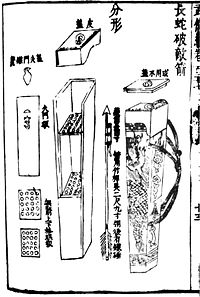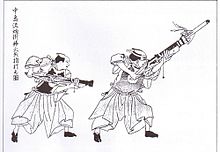Rocket launcher
This article needs additional citations for verification. (June 2013) |
A rocket launcher is a weapon that launches an unguided, rocket-propelled projectile.
History



The earliest rocket launchers documented in
Rocket launchers known as "wasp nest" launchers were used by the
Rockets were introduced to the
The collection of the royal armies includes man portable rocket launchers that appear (based on lock designs) to date from the two decades after 1820.[7] These don't appear to have entered general use and no surviving documentation on them has been found.[7]
During the American Civil War, both the US and the Confederate militaries experimented upon and produced rocket launchers.[8] Confederate forces used Congreve rockets in limited uses due to its inaccuracies, while the US forces used Hale patent rocket launcher which fired seven to ten inch rockets with fin stabilizers at a range of 2,000 yards (6,000 ft).
World War II
Pre-war research programmes into military rocket technology by many of the major powers led to the introduction of a number of
Types
Shoulder-fired
The rocket launchers category includes shoulder-fired weapons, any weapon that fires a rocket-propelled projectile at a target yet is small enough to be carried by a single person and fired while held on one's shoulder. Depending on the country or region, people might use the terms "
A smaller variation is the
Recoilless rifles are sometimes confused with rocket launchers. A recoilless rifle launches its projectile using an explosive powder charge, not a rocket engine, though some such systems have sustainer rocket motors.
Rocket pod
A rocket pod is a launcher that contains several
Large scale
Larger-scale devices which serve to launch rockets include the multiple rocket launcher, a type of unguided rocket artillery system.
See also
- Launch pad
- List of gun-launched missiles
- List of rocket launchers
- List of man-portable anti-tank systems MANPATS
References
- ISBN 978-0-521-30358-3.
- ^ Needham 1974, p. 493
- ^ Needham 1974, p. 495
- ^ Needham 1974, p. 514.
- ^ Congreve, William (1814), The Details of the Rocket System J. Whiting, London (p. 19)
- ISBN 1-59114-029-3(p.177)
- ^ a b Jonathan Ferguson (23 January 2023). Who would want a flintlock rocket launcher? With firearms and weaponry expert Jonathan Ferguson. Royal Armouries. Retrieved 23 January 2023.
- History. April 9, 2013.
- ISBN 978-1586637620(pp. 169-178)
- ^ Vectors Website - 7.0 Unguided Rockets.
